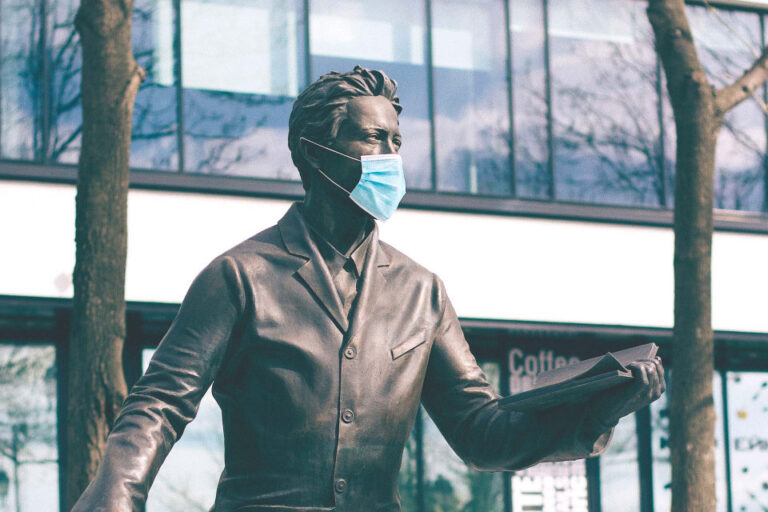On 1 January 2020, Stuart Carr scribbled a note to himself: “Welcome to 2020 – a year of transformation”. The changes he envisioned weren’t the changes the year threw up, but nevertheless the note was prophetic.
Pandemics are nothing new
As humans have spread across the world, they have carried diseases with them. In the second century, soldiers returning from Asia brought a plague to the Roman Empire that killed five million. In the 17th century, bubonic plague jumped from rats to humans and 25 million lives were lost to the aptly named Black Death. The Spanish Flu of 1918-1919 was the world’s deadliest pandemic with 50 million casualties. HIV/AIDS has killed 35 million people worldwide and although the symptoms can now be controlled with antiretroviral drugs, the disease is still ravaging many developing nations.
What about SARS?
The first SARS virus was more aggressive and more lethal than SARS-CoV-2 (COVID-19), which ironically made it easier to tackle. People who were exposed to someone infected with SARS had severe symptoms within two or three days of exposure, making contact tracing and quarantine more straightforward. SARS-CoV-1 killed around 770 people globally before it almost miraculously disappeared.
SARS-CoV-2 is not going to miraculously disappear so we need to adapt to a COVID world.
Holding pattern v adaptation
In March 2020, the NSW government imposed the first coronavirus restrictions. The directive was to stay home and limit gatherings to two people. There were some confusing details but one thing was clear our lives were being upended.
The Federal Government threw out the JobKeeper lifeline to suffering businesses to sustain them in the short term. Businesses could stay in a holding pattern and batten down the hatches or adapt to the changed world.
Don’t waste a crisis – time to reassess
The coronavirus crisis has presented an opportunity to businesses and individuals to reassess. Some have literally or figuratively cleaned up their businesses: tidying up, getting rid of old stock, reviewing entrenched systems and processes. Others have quickly pivoted: many restaurants entered the grocery market, a concert staging company switched to making desks for home offices, gyms hired out their fitness equipment and ran online classes, fashion labels adjusted their ranges to focus on comfy working-from-home wear, and local manufacturers harnessed their capabilities to produce PPE, sanitiser and ventilators.
Surviving in the new reality
As the coronavirus pandemic continues to disrupt the economy, the sad reality is that many businesses will struggle to stay open. Businesses that go into a holding pattern, hoping everything will return to normal are destined to fail. Those businesses that recognise change and take action give themselves a better chance.
The Greek philosopher, Epictetus (50-135AD) said, “We cannot choose our external circumstances, but we can always choose how to respond to them.”
Working from home: Pros and Cons
Businesses whose staff are still working from home, will need to plan a return to the workplace. They will need to make it attractive to return to the workplace. While there are many benefits to working from home, there are also many downsides.
Some of the pros and cons of WFH include:
Pro: No commute time or expense
Con: No separation between home and work
Pro: Extra time for errands and leisure
Con: Lack of community and workplace culture
Pro: Fewer interruptions and less small talk or gossip
Con: No opportunity for spontaneous sharing of ideas
Pro: Virtual meetings can save time
Con: Virtual meetings don’t suit everyone’s communication style
Pro: Unmonitored performance
Con: Unmonitored performance
Pro: Greater independence
Con: Greater isolation – mentoring and knowledge sharing are difficult to manage
The best solution might be the hybrid WFH model where employees work from home and on site. Some roles might be fully-remote, while others might work both from home and on site. Planning and consultation are key to make the hybrid WFH model work for the business. Post-pandemic working models might result in cost-savings from reduced office space, or businesses might consider housing teams in satellite and shared office spaces.
Lessons from COVID
Online sales
The pandemic has accelerated a number of changes. Online shopping has boomed with even those who were reluctant to shop online pre-pandemic taking it up out of necessity. No doubt, many people will not return to bricks and mortar shops, so businesses will have to consider their online selling options and improve their online supply chains to better manage online sales.
Virtual meetings
Similarly, the pandemic has hastened the take up of virtual meeting platforms. Virtual meetings have democratised the meeting space with international and interstate team members being at no disadvantage.
Even with vaccination programs rolling out around the world it will be some time before people will be travel with pre-pandemic freedom. Businesses will need to balance the cost and time savings of virtual meetings with the benefits of getting together in person.
Supply chain disruption
Shutdowns and border closures have disrupted supply chains to an unprecedented extent and highlighted the dangers of relying on global value chains. Some businesses are bringing processes in-house and extricating themselves from overseas and even interstate suppliers. This may be the beginning of de-globalisation with countries returning to manufacturing certain goods instead of relying on imports.
Skills shortages
Borders have been closed to tourists and also migrant workers. As certain industries ramp up, skills shortages and skills gaps among local workers are evident. Businesses need to be working with training providers for the long term to ensure skilled workers are available. Businesses should also be developing staff internally and succession planning.
The post-pandemic world
One thing we are learning from COVID-19 is how to deal with uncertainty. We are learning how to adapt to ongoing and ever-changing restrictions. We are learning how to embrace a digital world.
We don’t know what the post-pandemic world will look like, but we know it will be different; culture and identity, and what people value will change. Those businesses that choose to “not waste a crisis” will be better prepared and better set to manage in the post-pandemic world.
There will be winners and losers in the post-pandemic world.
The winners will be those who:
- Do something
- Try out new ideas
- Be lean and mean
- Accept and adapt to changes
The losers will be those who:
- Do nothing
- Don’t change or simply make cosmetic changes
- Don’t innovate
- Wait to see what happens




